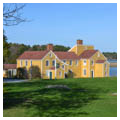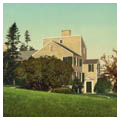Overlooking Little Harbor in the outskirts of Portsmouth, this rambling assemblage of building frames and rooms has no counterpart in surviving eighteenth-century New England houses. Despite its incoherent appearance, the house served after 1753 as the year-round home of royal governor Benning Wentworth, whose administration from 1741 to 1767 was the longest governorship in New Hampshire history; Wentworth was responsible for granting most towns in western New Hampshire and in the New Hampshire Grants, today Vermont. Having previously rented the brick Macpheadris-Warner House in downtown Portsmouth, Wentworth inherited this house and farm from his son John, who died prematurely in 1759, and between 1759 and 1765 employed a resident joiner named Neal to finish the interiors. The house is composed of four separate building frames, at least three of which were formerly freestanding structures that were moved and connected. The northwest building element, equipped as a kitchen, began its existence as a shop or warehouse with hewn and pegged (rather than planed and nailed) floorboards. The kitchen area includes a large cooking fireplace, two brick ovens, a buttery, and a small room with a potager or stew stove, which heated sauces over charcoal fires; this was used by a French-born servant who was familiar with Mediterranean cuisine. The gabled roof that intersects the vertical face of the uppermost lean-to structure covers an original flat deck, the earliest known in New England, which was waterproofed with tar and offered a panorama of now vanished formal gardens below. The most astonishing architectural feature of the house is a chimneypiece in the northeastern parlor, traditionally called the “council chamber.” This is a copy in wood of William Kent’s design of c. 1725 for the fireplace of the Stone Hall at Houghton, the Norfolk estate of British prime minister Sir Robert Walpole. Kent published the design in his The Designs of Inigo Jones (London, 1727), but the plate was plagiarized by William Hoppus in his The Gentleman’s and Builder’s Repository: or, Architecture Display’d (London, c. 1737). It is unknown which book guided the hand of the artisan, thought to be local carver Ebenezer Dearing (1730–1791), but Wentworth was acquainted with Newport architect Peter Harrison (1716–1775), who owned the only known copy of Kent’s 1727 folio in the colonies. The house retains one original beaufait (a built-in corner cupboard or sideboard), originally displaying silver and Chinese porcelain, and two others that were reproduced in 1966 from physical evidence. Two more, never reconstructed, once occupied corners in an upper parlor, which is also notable for its eighteenth-century flocked wallpaper. Bostonian J. Templeman Coolidge purchased the old Wentworth House in 1886 and proceeded over the next fifty years to restore the house and beautify the grounds.
You are here
Wentworth-Coolidge Mansion
1753 and later, from earlier 18th century building frames. 375 Little Harbor Rd.
Coordinator:
Bryant F. Tolles Jr. and James L. Garvin
If SAH Archipedia has been useful to you, please consider supporting it.
SAH Archipedia tells the story of the United States through its buildings, landscapes, and cities. This freely available resource empowers the public with authoritative knowledge that deepens their understanding and appreciation of the built environment. But the Society of Architectural Historians, which created SAH Archipedia with University of Virginia Press, needs your support to maintain the high-caliber research, writing, photography, cartography, editing, design, and programming that make SAH Archipedia a trusted online resource available to all who value the history of place, heritage tourism, and learning.




